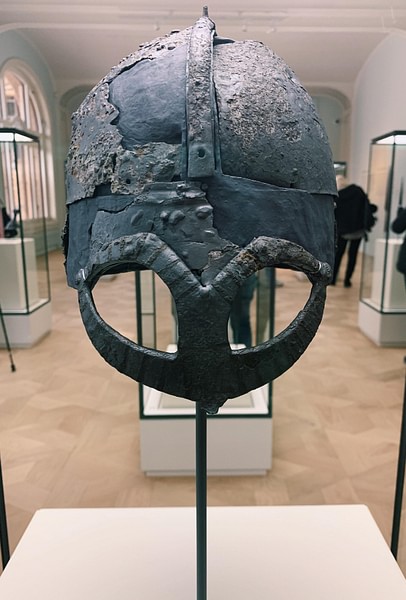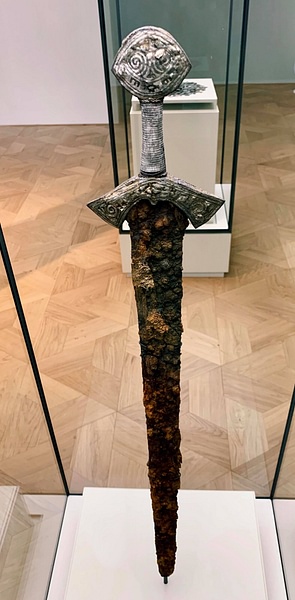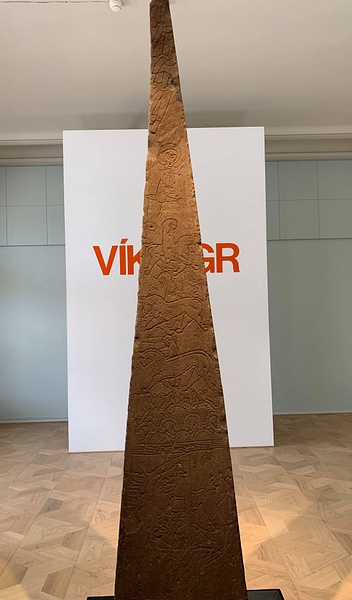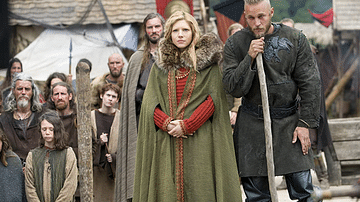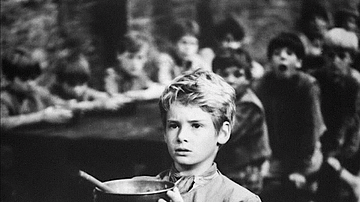In April 2019, The Museum of Cultural History in Oslo, Norway, opened its doors to the new exhibition VÍKINGR, containing rich treasures and unique archaeological finds from the Viking Age (c. 750-1050). The Viking Age is considered Norway's and the rest of Scandinavia's "golden age", and the tales of violent warrior seafarers have fascinated people all over the world for centuries. The Vikings are famous for their plundering of monasteries on the British Isles and the Viking helmet (wrongly depicted with horns in popular culture), but by visiting the VÍKINGR exhibition you will also learn that the Vikings were international traders, and that the Viking Age was an important period of transition in the northernmost part of Europe. This period saw the opening of new trade routes, the unification of Norway and the conversion to Christianity. The artifacts exhibited, including the world's best-preserved Viking helmet, the sword from Langeid and the largest Viking treasure ever found in Norway, are not only worth admiring for their beauty but also for what they can tell us about the Vikings' lives and values in a time of transition and change.
Walking into the exhibition, which is on the third floor of the museum, feels a bit like walking into a fancy jewelry store as it is beautifully curated with open spaces, complimentary colors and glass displays - very fitting for an exhibition consisting of invaluable jewelry, weapons, coins and other treasures. There are 20 items or collections of items on display, almost all inside the glass display cabinets, each telling their own story.
Trade & International Treasures
The first glass cabinets showcase jewelry and other items that are a testimony to the many different trade routes and international networks of the Vikings. The first Vikings of the 7th century were pirates in small ships, but by the 10th century, they had built larger ships that traveled further and they established larger armies and contact points in Europe and beyond.
The items in the first display tell the story of the establishment of the silver route connecting Scandinavia with the distant East. The treasure, consisting of several silver pieces and rings, as well as Arabian and Persian coins, was originally from areas in today's Iraq and Iran. The silver treasure traveled the long way to Norway in the 10th century, when the Vikings who were engaged in international trade brought large amounts of silver back to Scandinavia. Further proof of the Vikings' distant and exotic trade and international contact network can be seen in the next display, where the largest Norwegian Viking treasure ever found to date is showcased. The Hoen Hoard was found in 1843 in Buskerud, Norway and consists of large gold rings, Frankish gold jewelry, Arabian coins, colorful beads, a Roman antique gemstone, and an English ring. Admiring this beautiful treasure makes you wonder what stories the items would tell of their long journeys and their Viking owners.
Especially eye-catching are some of the gold objects, originally made in the Carolingian Empire (800-888). A large gold brooch is the most impressive piece, and it is believed to have adorned a warrior's belt at the Carolingian court before it was transformed into a brooch after coming to Norway. Other brooches are also showcased in the exhibition as they tell the story of objects that originally were used as decorative mounts on sacred objects used in churches in the British Isles. The objects were often refashioned into brooches after the Vikings raided many of these churches and brought the items back to Norway.
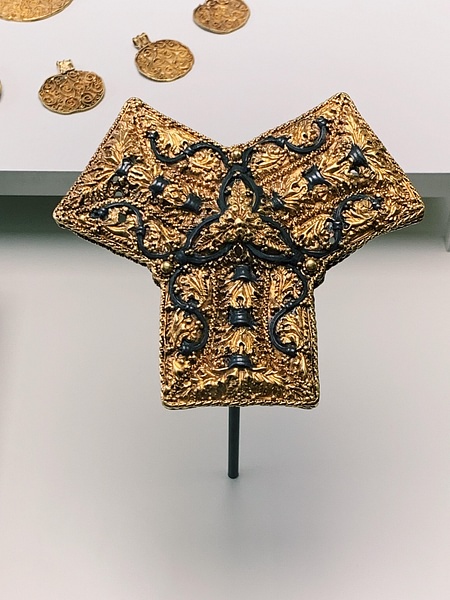
Warrior Vikings
Maybe the most exclusive and anticipated item in the new VÍKINGR collection is the Gjermundbu Helmet, the best-preserved Viking helmet in the world. With this, the next section of the exhibition starts, telling us about the more famous warrior Vikings. The Viking Age was a period of political unrest and violence in Scandinavia, and battlefield skills and courage were therefore celebrated as some of the most important capabilities in Viking society. The weapons, often richly decorated with symbols and patterns, symbolized a warrior's prestige and achievements. In later times, the Viking helmet became the strongest symbol of the Vikings, and to study the Gjermundbu helmet, therefore, feels like getting a glimpse into Scandinavia's violent past. It is intriguing and yet repulsive to imagine what the eyes looking out of this helmet witnessed sometime around the end of the 10th century.
Further, you can also study several Viking swords, including one bent sword. Breaking and bending the sword could have been a part of a burial ritual. For the Vikings the sword was often linked to myths about their production and their supernatural powers, making them objects that were either passed down through generations or destroyed so their destructive power would be eliminated and transferred with the owner to the world of the dead.
Another one of the swords, though not the best preserved or most richly decorated, gives us more insight into the Viking society due to the context in which it was buried and later found by archaeologists. The sword was found together with spears, a battle-axe, arrows and a skeleton. When finding warrior tombs, it is usually assumed that they belong to male warriors, but the remains in this burial were of a female - a girl who died at the age of 18-19. Together with similar finds of female remains in warrior and high-status burials in other parts of Norway and Sweden, this sword and skeleton tell the story of how women played a more important and possibly violent part in society during the Viking Age than previously assumed.
The New Faith
The most beautiful sword in the collection is The Sword from Langeid. This sword tells us the story of an important transition at the end of the Viking Age - the Vikings gradually giving up their Norse mythology while embracing Christianity. The Langeid sword is from the beginning of the 11th century and is impressively decorated with gold, silver and text in Latin letters. What is written is not known, as the text is hard to interpret, but the cross at the top of the handle is a clear testimony to the owner's Christian faith. The adaptation of the new faith developed over several generations, but it is widely accepted that Christianity became the national religion of Norway during or shortly after the death of St. Olaf (Olaf II of Norway - r. 1015-1028). After his death at the battle of Stiklestad in 1030, his influence as a saint on Norwegian society was important for the final overthrow of the ancient Norwegian worship of Thor, Odin, Freya and the other Norse gods and goddesses.
The transition to the new faith is also visible in the decoration on jewelry and other ornaments displayed in one of the last glass displays. The items, dating to 800-1100, are decorated with symbols of the competing faiths. The older jewelry embodies Thor's hammer Mjølnir, by many viewed as the symbol of Norse mythology, while the latter embodies the Christian cross.
Visitors will also notice a runestone standing freely between the glass boxes as it reaches towards the high ceiling. The stone is from the 11th century, and it also highlights the conversion to Christianity. The style of the writing and the practice of raising runestones date to before the Christian era. However, the symbols are clearly Christian as they depict scenes from the New Testament where the Three Wise Men are guided by the Bethlehem star to the stable where Jesus was born.
The Vikings sailed across the sea to explore new lands and conquer treasures, but in the process they were influenced by Christian Europe and eventually it would be the transition to Christianity that brought an end to the Viking Age and led Norway into the Hig Middle Ages (c. 1050-1537).
After experiencing the magnificent Viking objects, you can also visit a side room where you can study some of the objects in greater detail through various technological devices. You can look at the different layers of The Sword from Langeid through x-ray scanning, learn more about the use and symbols of the various brooches and explore the writing and symbols of the runestone by the use of laser.
More Vikings
The VÍKINGR exhibition is truly a "candy store" for history students and travelers, especially those interested in Viking history, and a visit to the Museum of Cultural History in Oslo and its treasures is something every Viking fan should add to their "bucket list". Also, if you have not had enough of Vikings after visiting this new exhibition, it is highly recommended to take a "Viking day" visiting the other part of the Museum of Cultural History: the famous Viking Ship Museum at Bygdøy. It is easy to reach this museum by bus (No. 30 bus towards Bygdøy), which stops right in front of the National Theatre, just a few minutes' walk from the Museum of Cultural History. The Viking Ship Museum houses three extraordinary and unique Viking ships, of which the Oseberg ship is the best preserved. The Oseberg ship dates to the first half of the 9th century and was discovered in 1904, with most of its astonishing decorations still preserved. The ship was found together with various treasures and objects as well as two female remains, making it probable that this was a burial site of a high-status or royal woman and possibly her slave – though later studies suggest the second woman may also have belonged to the higher classes of Viking society.
In the future, the VÍKINGR exhibition at the Museum of Cultural History and The Viking Ship Museum may merge as a larger Viking Age Museum, which will be built where the Viking Ship Museum is located today. The wonderful VÍKINGR exhibition will, however, continue as a permanent exhibition at the Museum of Cultural History for at least five years - when it possibly will be moved to Bygdøy.

